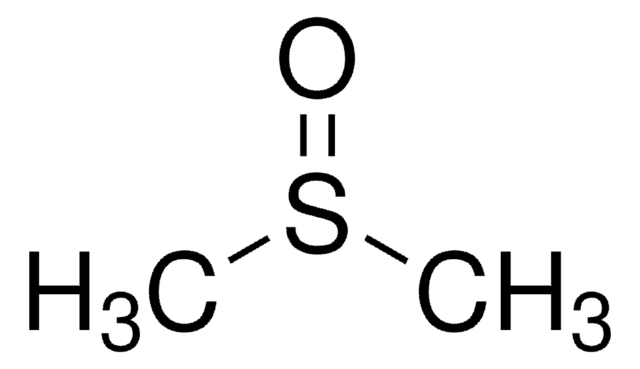154938
Dimethyl sulfoxide
ACS spectrophotometric grade, ≥99.9%
Synonym(s):
DMSO
About This Item
Recommended Products
grade
ACS spectrophotometric grade
vapor density
2.7 (vs air)
vapor pressure
0.42 mmHg ( 20 °C)
Assay
≥99.9%
form
liquid
autoignition temp.
573 °F
expl. lim.
42 %, 63 °F
technique(s)
UV/Vis spectroscopy: suitable
impurities
≤0.001 meq/g Titr. acid
≤0.100% water
evapn. residue
≤0.0100%
color
clear colorless
refractive index
n20/D 1.479 (lit.)
bp
189 °C (lit.)
mp
16-19 °C (lit.)
density
1.10 g/mL (lit.)
λ
H2O reference
UV absorption
λ: 270 nm Amax: 0.40
λ: 290 nm Amax: 0.18
λ: 310 nm Amax: 0.06
λ: 330 nm Amax: 0.02
λ: 350-400 nm Amax: 0.01
SMILES string
CS(C)=O
InChI
1S/C2H6OS/c1-4(2)3/h1-2H3
InChI key
IAZDPXIOMUYVGZ-UHFFFAOYSA-N
Looking for similar products? Visit Product Comparison Guide
Caution
Other Notes
Legal Information
suggested gloves for splash protection
Storage Class Code
10 - Combustible liquids
WGK
WGK 1
Flash Point(F)
188.6 °F - closed cup
Flash Point(C)
87 °C - closed cup
Personal Protective Equipment
Regulatory Information
Choose from one of the most recent versions:
Already Own This Product?
Find documentation for the products that you have recently purchased in the Document Library.
What is the molarity of DMSO?
DMSO will have a molarity of 14.1M, based on a density of 1.1 g/mL and a molecular weight of 78.13 g/mol.
What is the DMSO dissolved in?
DMSO is not dissolved in any solvent. It is a pure chemical compound that is a liquid at room temperature.
Where does DMSO come from?
DMSO is known to have been isolated from tree bark in the past. It is now a commericially synthesized solvent.
Does DMSO have any synthetic utility?
DMSO has been used to oxidize thiols and disulfides to sulfonic acids, hydrolysis of epoxides, thioalkylation of phenols, and oxidation of primary alcohols and halides, and esters of primary alcohols to aldehydes.
Which document(s) contains shelf-life or expiration date information for a given product?
If available for a given product, the recommended re-test date or the expiration date can be found on the Certificate of Analysis.
Dimethyl sulfoxide (DMSO) should be a liquid. Why did it arrive as a solid?
DMSO supercools easily, and re-melts slowly at room temperature. The melting point is 16-19 °C. The solidified product can be re-liquefied by warming to room temperature without detriment to the product.
How do I get lot-specific information or a Certificate of Analysis?
The lot specific COA document can be found by entering the lot number above under the "Documents" section.
How do I find price and availability?
There are several ways to find pricing and availability for our products. Once you log onto our website, you will find the price and availability displayed on the product detail page. You can contact any of our Customer Sales and Service offices to receive a quote. USA customers: 1-800-325-3010 or view local office numbers.
Is Dimethyl sulfoxide a sterile product?
No, this product is not considered sterile. Product Nos. D2560 and D2438 are sterile-filtered.
What is the Department of Transportation shipping information for this product?
Transportation information can be found in Section 14 of the product's (M)SDS.To access the shipping information for this material, use the link on the product detail page for the product.
My question is not addressed here, how can I contact Technical Service for assistance?
Ask a Scientist here.
Our team of scientists has experience in all areas of research including Life Science, Material Science, Chemical Synthesis, Chromatography, Analytical and many others.
Contact Technical Service
